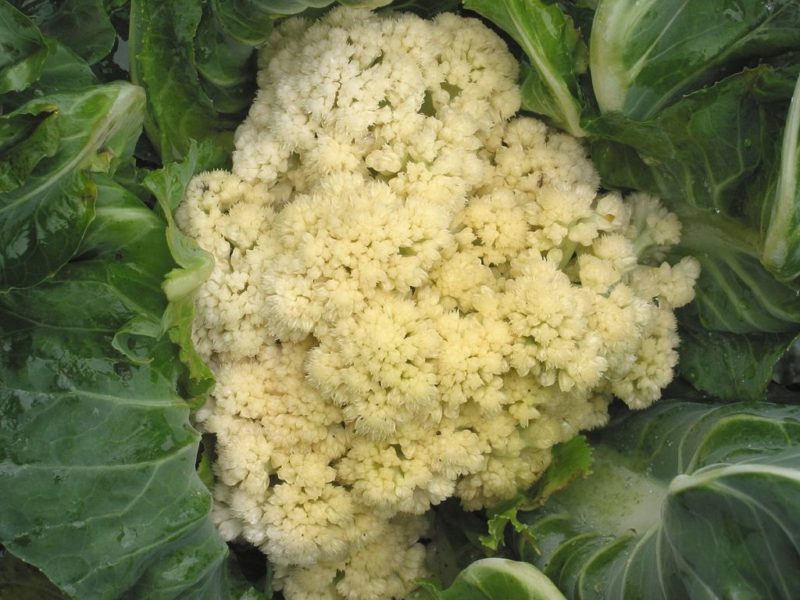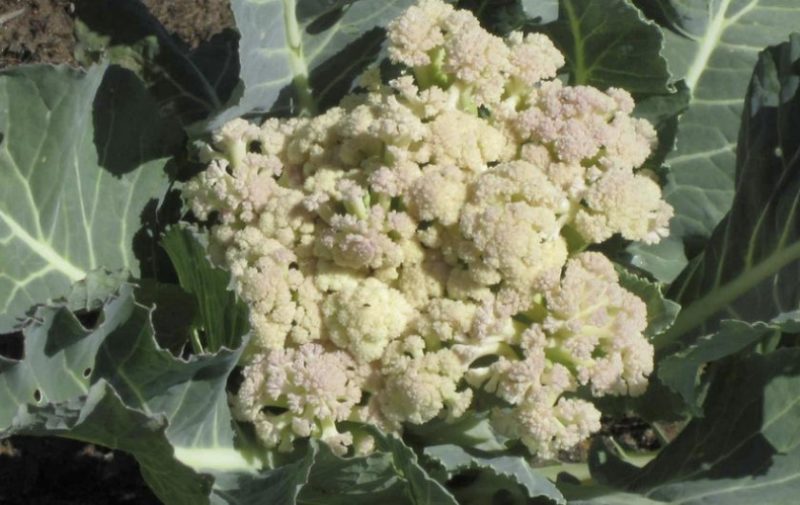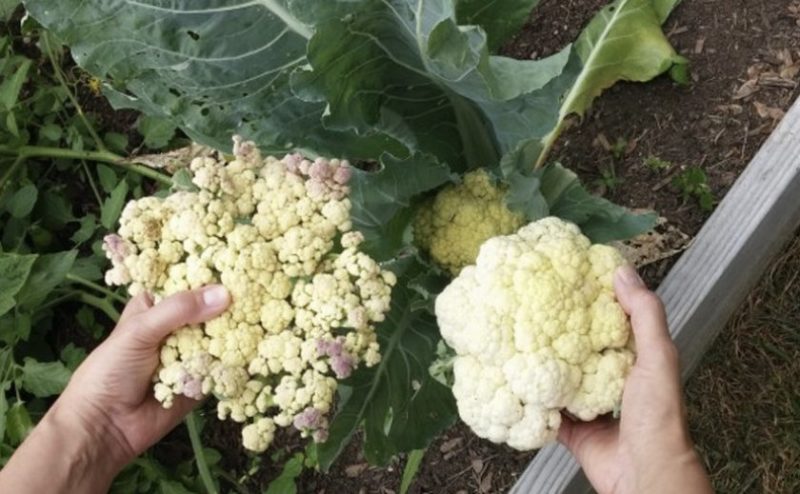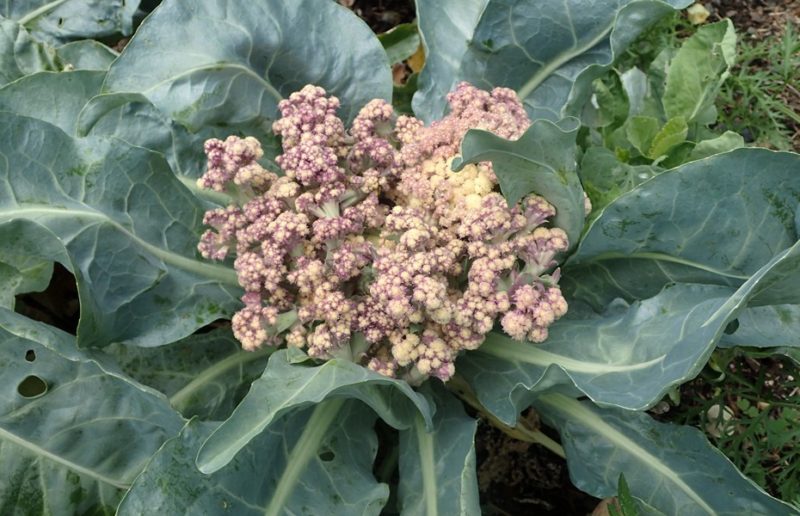If cauliflower has bloomed, what to do with it and can you eat it
Gardeners accustomed to unpretentious white cabbage growing often do not notice that the cauliflower crop is fading. Some, knowing that this is critical for most crops, dig out an unsuccessful bed, and send the shoots to feed livestock. However, it is possible not to reach the ejection of the inflorescences, and the heads remaining after the removal of the flowering stems can be eaten.
The content of the article
If the cauliflower has bloomed, can it be eaten?
There is a cauliflower that has bloomed, you can safely. Rumors about the poison in a reborn form and the accumulation of toxins are not confirmed. Cultivation problems only affect the aesthetic appearance of the crop. The weak form of flowering practically does not affect the taste and nutritional value. Just blooming ovaries become tough and may taste a little bitter.

Cauliflower, in which all the ovaries have turned into bouquets, is not suitable for food, but also not dangerous. It can be fed to livestock and poultry.
Having received a blooming crop, you just need to choose the right recipes. You won't be able to cook vegetables in batter from such a growth, but cabbage is suitable for other dishes:
- soups and mashed potatoes, filling for baking;
- stew and vegetable hodgepodge, combined vegetable side dishes;
- salads and canned food, implying a small shredder.
Bloom gives bitterness. If you soak these stems in cold water for 2-3 hours, the taste will go away.
Why does cauliflower bloom?

The cauliflower brought to the territory of Russia by Catherine the Great did not finally take root. The capriciousness in cultivation and good performance of the closest local competitor, white cabbage, stop the spread of cauliflower.
It is generally accepted that curly cabbage leaves in color because of the inability to grow it, through an oversight of the gardener.
In fact, cauliflower turns into color for reasons beyond the control of the gardener:
- The hybrid, bought as seed, turned out to be unsuccessful. The selection of cauliflower has not been carried out for a long time. The varieties and hybrids that go to the shelves are not fully understood, and the batches may be defective. Reviews of gardeners, whose bags from the same manufacturer fade in color on opposite ends of the country, prove this.
- Hereditary species problems... The peculiarity of the selection of cauliflower is that the seeds are actively produced by plants with a small and loose head of cabbage, and they have dense, wide agricultural value. Collecting seeds from a failed unit will lead to problems the next harvest. To avoid them, agricultural technicians recommend not to get carried away with their own breeding of varieties and hybrids, not to buy material for planting from dubious distributors, but to order material with the F1 marking directly from breeding centers - that is, direct collection of the maternal high-quality line.
- Wrong hybrid chosen, for example, in the middle lane planted one that is designed for a long southern summer with short daylight hours. To form ovaries, cabbage needs shade and warmth at the same time. It does not tolerate both the lack of sun during the germination period and its abundance during the formation of the lateral heads. The critical level is considered to be a temperature of + 18 ° C. The long daylight hours with the scorching evening sun, typical for the Volga region and the middle part of the country, do not provide the necessary conditions. Climatic changes, resulting in droughts in the middle latitudes, exacerbate the situation.Not receiving a signal about the optimal climate for the ovaries, the cabbage goes into bloom.
- Natural "hybrids" obtained by crossing incompatible varieties got into the seed material. Agricultural technicians recommend keeping only one area for the seed fund, carefully protecting it from getting into the planting of other varieties.
- The opposite situation with the same outcome occurs if the bush did not receive enough heat. Cold summers or short but significant frosts during the head formation period weaken the plant. Realizing that there are no conditions for the full-fledged formation of heads of cabbage, it begins to throw out arrows.
- Lack of moisture during head formation (lack of natural watering, insufficient artificial) also shows the plant that the time for abundant growth in thickness has not yet come. Refusing to bush, cauliflower waits for the desired indicators. The optimum humidity is 80%. Having reached the cold weather, the plant will grow.
- It is difficult to grow cauliflower on poor soils with a lack of trace elements. Even on black soil, the area for cauliflower is abundantly fertilized with both complex artificial compounds and humus. Organic is the best feeding for the prevention of flowering of a vegetable.
- Crop rotation errors impoverish the soil. In order to create optimal conditions for cauliflower, it is necessary to take into account the peculiarities of the crop that was on this site last season. Do not plant cauliflower after radish, radish, turnip. You can highlight the area where tomatoes, potatoes, onions, cucumbers and cereals grew. Another mistake is planting cauliflower in the same place for several years in a row. The change of species (from white to colored) does not solve the problem.
The early departure of cabbage into arrows is a consequence of species problems, mistakes in collection and selection, and a reaction to an unsuitable climate. The last reason is the most common. The short Ural and Siberian summers are not enough for the cauliflower to confidently rise, grow stronger, form foliage and head ovaries. Cultivation under such conditions is carried out with additional stages, even if the main one is open ground.
To get a harvest, the gardener can repeat the steps:
- Sowing and growing seedlings in room conditions, providing temperature and humidity conditions (March - April).
- Growing seedlings in greenhouses and hotbeds until the ovaries are strong and ready to be transferred to the ground. The land to which it is planned to transfer the seedlings should by this time have warmed up to + 15 ° C (May).
- Planting in the ground for the main period during the active growth phase (end of May - June).
- Digging out bushes and growing in greenhouses during the period when growth in the open field is impossible due to autumn frosts (September).
If several attempts at growing cauliflower have failed, you can switch to broccoli farming. A related species is no less rich in vitamins and trace elements, but less demanding on growing conditions.
When growing, follow the recommendations:
- wrap seedlings on cold nights;
- regularly loosen and mulch the soil;
- timely cover the bare stem with earth;
- keep a distance of at least 490 cm when landing;
You can wait out the early May sun - dig out the seedlings and plant again after 2-3 weeks.
Read also:
What to do if cauliflower has bloomed

Constant monitoring of the state of plantings will tell you when the cabbage from tillering is ready to go into the arrows.
Flowering phases:
- the appearance of thin arrows knocking out of the size of the bush with small primordia;
- regeneration of primordia into full-fledged brushes and buds, strengthening of the stems;
- opening of buds and abundant color.
Having managed to identify the first phase, the gardener can stop the process.The first sign: just entering the formation phase, the head begins to separate, becomes loose, lighter shoots appear on its surface - future arrows. Small leaves and stamens begin to appear in the inflorescences - the head ceases to be uniform.
Important! During the formation of inflorescences, cabbage is especially sensitive to moisture, and bright light is contraindicated for it. Abundant watering and shade is the best prevention of flowering.
It is also possible to stop the growth of shoots at the stage when the first arrows have already begun to grow. Processing of cabbage preparing to bloom:
- Shoots that come out in color are cut at the root. Only stumps of no more than 3 cm in size should stick out of the ground.
- The soil around the root is loosened. Nitrogen-phosphorus fertilizers are added to the soil, for example, ready-made compositions "Nitrofosk", "Ammofosk".
- When new shoots appear on the remainder of the stem, remove the middle ovaries. The lateral ones are left to control their growth.
Another trick of growing dense and non-flowering heads of cabbage is to attract shoots. At the stage of mass gain, small heads of cabbage are wrapped and tied with long grass or a soft elastic band - they attract, trying to create dense inflorescences, but not damage or block access to the sun. Reception is relevant only for the phase of active growth and in conditions of excessive sun exposure.
Important! If the flowering happened in June, you can try to grow a second crop with growing in a greenhouse - sow a new batch and in September transfer the shoots to the greenhouse, keeping the distance between them.
What does overripe cauliflower look like?

Correctly grown cauliflower is matt, almost white or light green with a uniform color. Its inflorescences are dense, not collapsing from pressure and shredding.
Overgrown or malformed cauliflower gives out a problem in appearance:
- The head is loose, heterogeneous, easily broken in the hands.
- On the surface of the plants, there are stamens and small foliage.
- The color of the head of cabbage has become yellowish or brownish, heterogeneous.
- On the inflorescences appeared spots, blotches of brown color.
- The stalk of such a cabbage is long, dryish.
Is it okay to eat overripe and yellowed cauliflower
An unpleasant yellowish head of cabbage interspersed with it is not an obstacle to eating. If burnout and sunburn only give out color, the vegetable can be refreshed:
- add 1 tbsp for 3 liters of water. l. citric acid;
- soak the cabbage for 5-10 minutes (no more need, otherwise it will absorb excess water);
- let the water drain onto a napkin.
When the head of cabbage dries, it will return to its white matte appearance.
Read also:
The use of cauliflower for weight loss
Conclusion
It is difficult to grow a capricious culture so that the forks turn out to be beautiful, uniform, dense. You can also eat ovaries after flowering, if you choose the right recipe. There is no poison or toxins in such inflorescences. The crop itself can be saved by pruning and tightening the heads.